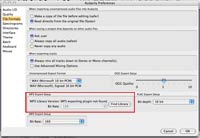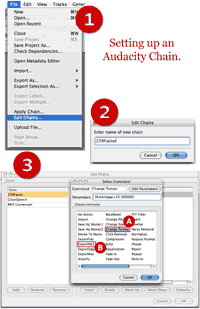Part of the Faster Podcasts Series
- Speeding up podcasts:
Listen to more, faster – Part 1 - Speeding up Podcasts part 2:
Using Audacity to speed up MP3s - Speeding Up Podcasts part 3: Make Yourself an Audiobook

I established in the previous article that with all the interesting content out there, it can be quite daunting to listen to all those great podcasts. The ease with which iTunes lets you discover, subscribe to and manage podcasts can quickly lead to an overwhelming number of episodes and timespan to get through. "Podcast Overload" is a very real possibility.
I also noted in that article that Apple’s Quicktime Player application can be used for faster playback… if you happen to be sitting at a computer. But what if you want to take advantage of the "pod" part of a "podcast" and listen on-the-go?
Luckily for us all, there are a couple of ways to speed up your spoken word audio before you pack it up and take it with you. Specifically, there are two main approaches, and each has its advantages and weaknesses. The first method involves using an audio processing program to decrease the total running time of a podcast before copying it to your iPod. Alternately, if you have an appropriate model (4G and later or any Nano), you can format your files so that the iPod itself adjusts the playback speed in real-time.
This approach has two principal advantages:
- Flexibility: Audio processing gives you the greatest amount of control over the final playback speed of your podcasts. Speed it up by 10% or 200%, whatever works for you.
- Organization: Because you are editing and replacing the original downloaded podcasts, you can maintain the organizational functionality present in iTunes + iPod.
However, this approach comes with trade-offs:
- Processing time. Running an audio file through a sound editor takes time. If you want to increase the playback speed, you have to run it through the processor before dropping it onto your iPod.
- Potential Zero-sum changes. Whether a project is even worth attempting depends on the likelihood of a net gain in time. If it takes you 5 minutes of computer use + processing time to shorten audio by 4 minutes, then you would have been better off just listening to it in the first place. This consideration is increasingly relevant for older computers with slower CPU speeds and longer processing times.
- Inflexibility. Ironically, the other disadvantage of this approach is inflexibility. Once you’ve processed the file, you’re stuck with it. If you’ve happened to set the speed to a rate that is uncomfortable or impossible to listen to, then you’ll probably have to re-download the podcast and try again.
![]()
Bearing all that in mind, just how does one speed up a podcast? Easy: Audacity, an open-source audio program that’s packed with features, cross-platform, fairly simple to use, and of course, free. In fact, the program is most likely used in the actual production of many of the podcasts you’ll be modifying.
Additionally, you’ll need the LAME mp3 encoder to save your processed files back to mp3 after Audacity is finished with them.
Audacity also supports batch processing (called "Chains" in its parlance) that allows you to open multiple files, run filters, and save back to mp3 with just a couple of clicks. Not bad, but how’s it work with iTunes?
In basic form, the workflow looks like this:
- Podcast is downloaded. MP3 file is saved into your iTunes Music > Podcast folder and the appropriate entry appears in iTunes’ Podcast panel.
- Said mp3 file is opened in Audacity. Modifications are made.
- New, faster mp3 file is exported.
- Original mp3 is replaced.
- iTunes entry is updated with a shorter playing time.
- Profit?
Alright, now that we know what we’re in for, let’s walk through the procedure.
Install and Configure Audacity with LAME mp3 encoder
Download Audacity and LAME encoder for your system. Version 1.3 (beta) is required for batch/chain processing.
Now to configure.
Once Audacity is installed, we need to tell it where the LAME encoder is. So, launch the program and select the Preference menu item. Under the file formats section, choose "Find Library" next to MP3 Export Setup. Also, choose the bitrate to save your modified podcasts at. Most podcasts are published between 64kbps and 128kbps. In my experience, 64kbps provides sufficient quality for listening to spoken word, though you should adjust it to fit your preference.
Next, we just need to set up a Chain. Chains are like scripts inside Audacity that automate a string of operations. For our purpose, we need to build a chain that imports the mp3, changes the tempo, and re-encodes it back to mp3. It’s really easy, so let’s get it set up.
- From the File menu, select "Edit Chains." You’ll be presented with a box showing the pre-configured Chains.
- Click "Add" and give the Chain a name (ex: 25%Faster)
- Then click "Insert" to add a step to the process. You don’t need to tell the Chain to import a file. That happens automatically when you run it. So the first thing to do is select "Change Tempo" not Change Speed. Change Speed will affect the pitch of the audio, like speeding up a cassette tape or turntable (aka "chipmunking"). Change Tempo leaves the pitch as it is.
- In the Parameters field, enter to amount to speed up by. 20% will result in 48 seconds for every 60. 200% will result in 30 seconds for every 60.
- Next, click Insert again and select "ExportMP3." That will complete the Chain.
- At this point, you can create multiple Chains for different speeds if you want. One for 15%. One for 50%, etc. When you’re done, close the Chains window.
Two steps, that’s it. Change tempo -> ExportMP3.
Let’s Get Speedin’
Now that Audacity is all set up, we can do the actual processing.
- From the File menu, select "Apply Chain" and select the one you created earlier. Click "Apply to files."
- Navigate to where your podcast files are stored. Unless you’ve changed your iTunes settings, they’ll be in your "iTunes Music" folder, in a folder called "Podcasts."
- Select the files you want to speed up. On a Mac, hold down the Command/Apple key to select more than one file. On Windows, use the Control key.
- Click "Open." Audacity will begin processing the files. When it’s finished, you’ll see a folder called "cleaned" with your originally downloaded files. Inside that folder is your shiny new faster podcasts.
- Move the new files out of the "cleaned" folder. When asked if you want to over-write the existing files, say yes.
IMPORTANT: If you want the option of re-processing the files at a different rate, copy or duplicate (don’t just move) them to another folder before replacing. - Open iTunes and click on Podcasts from the source view. Select the episode that you modified. The time should change, but if it doesn’t, get info on it. That will force iTunes to refresh the display.

Ta-da. Welcome to the world of faster podcast listening. The next time your iPod is updated, the new faster podcasts will be copied and you can take them on the road.


For my accelerated podcasting, I use a program from Doug’s Applescripts (Mac only) called Join Together.
http://www.dougscripts.com/itunes/scripts/scripts07.php?page=1#jointogether
The purpose of Join Together is to convert tracks to AAC, and splice them together in Quicktime to create a chapterized AAC file. One of the options is to make the resulting joined file “bookmarkable”, which means iTunes will treat the file like an audiobook, which can be sped up on the iPod. (in fact, it will appear under “Audiobooks”). Here’s what I do:
1) I have a smart playlist of the day’s newly downloaded podcasts, sorted from shortest to longest (that’s my personal preference).
2) I select the files in the smart playlist.
3) I run Join Together (unlike most of Doug’s scripts, it’s a standalone program instead of an Applescript run in iTunes). “Make bookmarkable” needs to be selected.
4) Voila! It takes a while for Quicktime to export, but the result is an audiobook of your selected podcasts. Like all audiobooks, you have the option of listening to them at a faster speed. (BTW, at this point, I delete the original files from my smart playlist (use alt+delete) to avoid podcasts that are redundant podcasts. 😉
This is also a great program to use if you’ve ever ripped an audiobook from CD and would like to covert it into the actual audiobook format.
If you don’t want to join the files, you can convert them to AAC, and use Doug’s script “Make Bookmarkable”. which will convert the individual unjoined files into Audiobooks.
http://www.dougscripts.com/itunes/scripts/scripts07.php?page=1#makebookmarkable
Reply
tunequest Reply:
February 20th, 2007 at 4:36 pm
Hey Jeff, thanks for the tip. Converting to an AAC-audiobook will be the subject of my third post on accelerating podcasts, so stay tuned for that. A question about Join Together: does that create audiobook chapters, like an Audible.com .aa file? If so, that would be a nice way to create a digest of podcasts into a single file.
One of my biggest annoyances is how the iPod stops playing at the end of an episode, rather than continuing to the next. For subscriptions like The Onion Radio News, where the episodes are ~60 seconds, it can be frustrating to listen to a batch of them in one sitting.
But the method I describe above has its merits, especially for owners of older iPod models that don’t support onboard acceleration. Plus you get to keep iTunes’ nifty podcast directory.
Reply
Jeff Reply:
February 21st, 2007 at 1:04 pm
Tunequest,
Yes, Join Together creates Audiobook chapters of the files joined together. If I remember right, you have to download an Apple app called ChapterTool, which works in the background to chapterize the joined files (Doug provides a link).
Sidenote: I plan to use Join Together to splice together some longer classical bits. Most of my Mahler symphonies have each movement broken up into a bunch of tracks, and I realized yesterday that using Join Together, I can have the best of both worlds — the whole movement together as one file, but with the ability to jump to specific sections within the movement. A purist could argue that all movements of a symphony should be joined since each movement is a “chapter” of a larger work, but I’m not ready to go there yet.
I’m actually going to try using your Audacity method for the very reasons you described — you still get to use the podcast directory. Plus, you have control over the acceleration. Sometimes, the iPod’s version of faster isn’t fast enough.
I too subscribe to Onion Radio news and feel your pain. A very simple workaround that doesn’t involve accelerating or joining is to use smart playlists to listen to podcasts — continuous podcast playback.
Reply
tunequest Reply:
February 22nd, 2007 at 6:45 pm
Thanks for the tip about Join Together. I’ll definitely have to play with that.
And that’s a cool idea for classical movements. I tend to shy away from releases that are split into individual segments because they are difficult to deal with. I’ll have to store that little trick away for future reference.
Also, I’ve used that smart playlist trick before, but it doesn’t work on the iPod if it’s set to shuffle at all. It’ll only play one file then stop in that case. Took me a while to figure that one out.
Reply
You can prevent your iPod from stopping at the end of each podcast by turning off shuffle in settings. Podcasts are excluded from shuffling so it stops between each one.
My 5th gen video has a “shuffle songs” option which I use when I want to shuffle music and I leave shuffle off in the settings menu.
Reply
In my Audacity, in the preferences window, it won’t allow me to set the bitrate for exporting mp3’s… i’ve downloaded the LAME library and selected it, and it is listed as selected, but no further preferences show up. anyone else have this problem? thanks
Reply
david Reply:
January 14th, 2008 at 12:58 am
A personal and simple tip … I found it useful to audition some of each audiobook at faster speeds in Quicktime (using the AV prefs to adjust playback speed). This way you can check each audiobook/podcast out to see what speed-up percentage feels right before running the whole batch through in audacity.
Also, I had the same issue w/ Audacity/LAME and not being able to set bitrate … it ended up doing 64 kb – which is what i wanted anyway.
Reply
tunequest Reply:
January 14th, 2008 at 10:47 pm
That’s a great tip david! If you’re running a Mac, be sure to grab the Applescript from the first article in this series. It’s a shortcut to audition files in Quicktime Player from inside iTunes.
Thanks for stopping by.
Reply
Hi everyone! I was able to set up batch processing for changing the temp, however! I have hundreds of individual folders that contain audio books, and I need to be able to set it, and forget it! It seems Audacity can only select individual files?.. I have a PC.. Please help!!!!!
Thank you.
Reply
All of these tips seem to be for audio podcasts only? I have several video podcast lectures that I would like to speed up to watch on my ipod, does anyone have suggestions on doing this?
Reply
Roberto Reply:
January 28th, 2009 at 4:15 pm
Hey Ben-
Were you able to figure out how to speed up the video lectures?
R.
Reply
Learning the chain process in Audacity has been well worthwhile. I now rip audiobooks with Bonk and turn Audacity loose to speed the tempo of each file up 30-40%. It works and works well. The sped-up audiobook is easier listening for me and holds my attention better. One note: you must double-click to set up the chain preferences—a single click is ignored.
Reply
I’m glad you’re writing on this subject, but you may be the least concise technical blogger I’ve ever seen! It’s a blog, not a LiveJournal!
In any case, thanks for your tips.
Reply